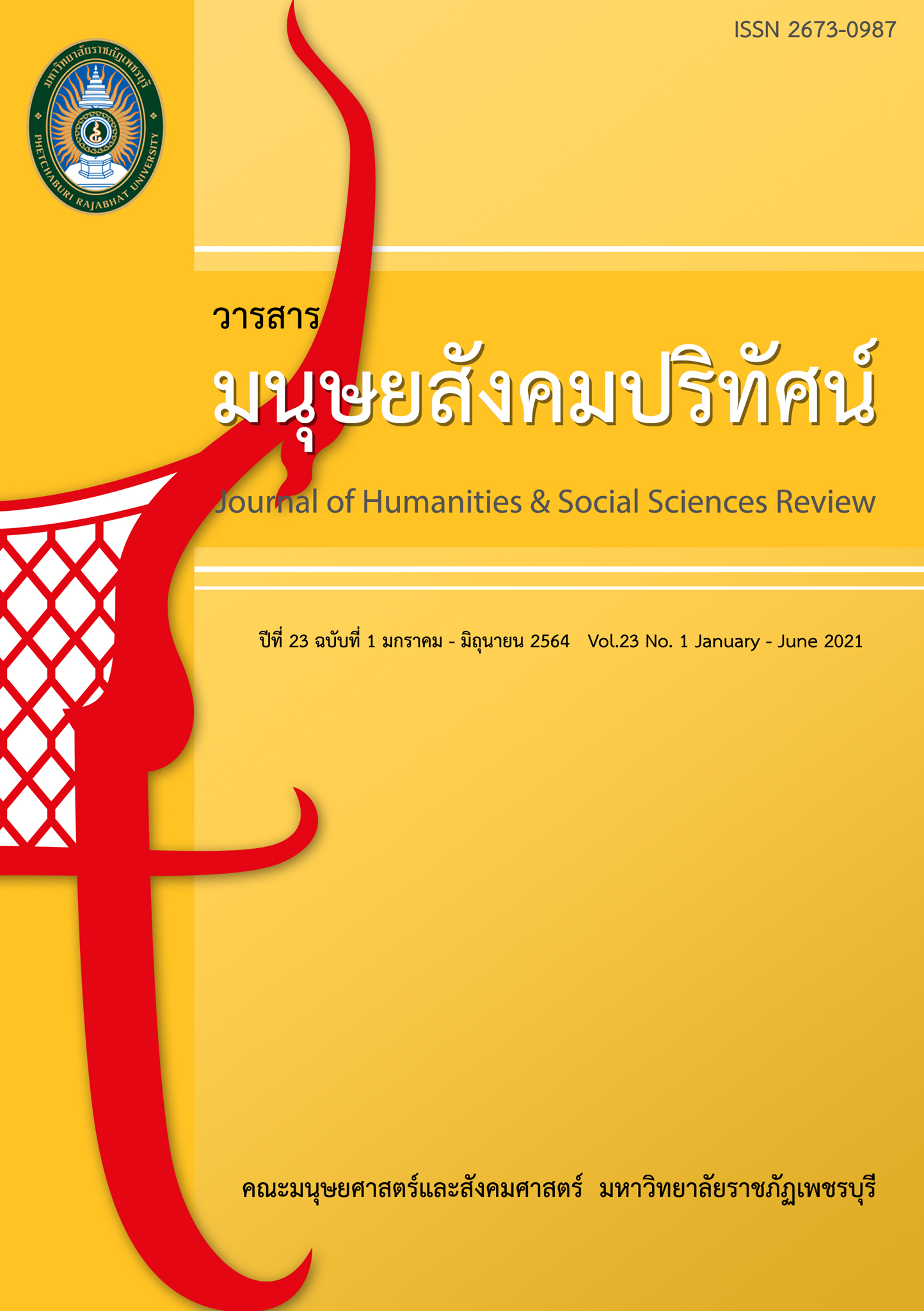The Relationship between the King and Mueang Phetchaburi during the Reign of King Rama IV to King Rama VI (A.D. 1851 – 1925)
Main Article Content
Abstract
The objective of this research was to studythe relationship between the King and Mueang Phetchaburi during the Reign of King Rama IV to King Rama VI. It was found that Phetchaburi had been developed as a city that had the potential to welcome foreigners entering Thailand. During that time, there were tremendous social and economic changes in Mueang Phetchaburi.This came from the relationship between the King and the people of Mueang Phetchaburi.The change took place as Western influence came after the Bowring Treaty during the reign of King Rama IV. Therefore, Siam had to improve the country to be comparable to the western in every aspect.
The change brought improvements to the country in all areas in order to have prosperity equal to the West, including the development of the country in the region. It spreadthose influences into the region. Phetchaburi was developed under that influence as well, with both concrete and abstract evidence such as palaces, roads ,and bridge construction.These things made the people of Mueang Phetchaburi attached to the King, and that relationship still exists today.
Article Details
1. Any views and comments in the article are the authors’ views. The editorial board has not to agree with those views and it is not considered as the editorial board’s responsibility. In case, there is any lawsuit about copyright infringement, it is considered as the authors’ sole responsibility.
2. The article copyright belonging to Faculty of Humanities and Social Sciences, Phetchaburi Rajabhat University are copyrighted legally. Republication must be received direct permission from the authors and Phetchaburi Rajabhat University in written form.
References
2. กองจดหมายเหตุแห่งชาติ. เอกสารกรมราชเลขาธิการ รัชกาลที่ 5กระทรวงวัง มร. 5รล/7 เรื่อง ปลูกต้นไม้ที่พระราชวังบ้านปืน (28 พฤษภาคม – 19 กันยายน 2453)
3. กองจดหมายเหตุแห่งชาติ. เอกสารกรมราชเลขาธิการ รัชกาลที่ 6 กระทรวงวัง มร. 6 ว/1 เรื่อง ทำทางรถไฟหาดเจ้าสำราญ (6 พฤษภาคม 2462 – 23 สิงหาคม 2465)
4. เจ้าพระยาทิพากรวงศ์. (2477)พระราชพงศาวดาร กรุงรัตนโกสินทร์ รัชกาลที่ 4 พ.ศ. 2394 – 2411. พิมพ์เป็นที่ระลึก ในงานพระราชทานเพลิงศพ คุณหญิงธรรมสารเนติ (อบ บุนนาค) วันที่ 17 กุมภาพันธ์ พ.ศ.2477 ณ วัดประยูรวงศาวาส.พระนคร:โรงพิมพ์พระจันทร์ ท่าพระจันทร์. สืบค้นเมื่อ 28 กรกฎาคม 2563,จากhttps://vajirayana.org.
5. ฉลอง สุนทราวาณิชญ์. (บรรณาธิการ.). (2550). สมุดราชบุรี พ.ศ. 2468 (พิมพ์ครั้งที่ 2). กรุงเทพฯ: สมาคมมิตรภาพญี่ปุ่น – ไทย.
6. ฐิติมา สุวรรณชาติ.(2559). ประวัติศาสตร์เพชรบุรี. เพชรบุรี: มหาวิทยาลัยราชภัฏเพชรบุรี.
7. ประวัติศาสตร์เมืองเพชรบุรี. (ม.ป.ป.) สืบค้นเมื่อ 28 กันยายน 2559, จาก http://research.pbru. ac.th/web/index.
8. พยุง วงษ์น้อย. (2557). พื้นภูมิเพชรบุรี: ภูมิสถานโครงการจัดทำหนังสือเฉลิมพระเกียรติ มหาวิทยาลัยราชภัฏเพชรบุรี. เพชรบุรี: มหาวิทยาลัยราชภัฏเพชรบุรี.
9. มนู อุดมเวช. (2531).งานวิจัยเรื่องเพชรบุรีสมัยอยุธยาและรัตนโกสินทร์ตอนต้น. เพชรบุรี: วิทยาลัยครูเพชรบุรี.
10. มนู อุดมเวช และคณะ. (2559). พื้นภูมิเพชรบุรี: ภูมิประวัติ โครงการจัดทำหนังสือเฉลิมพระเกียรติ มหาวิทยาลัยราชภัฏเพชรบุรี. เพชรบุรี: มหาวิทยาลัยราชภัฏเพชรบุรี.
11. วรางคณา นิพัทธ์สุขกิจ. (2561). การเสด็จประพาสเมืองเพชรบุรีสมัยรัชกาลที่ 4 – รัชกาลที่ 6. วารสารประวัติศาสตร์ มหาวิทยาลัยศรีนครินทรวิโรฒ, 43: 47–72.
12. เสยย์ เกิดเจริญ. (2523). พระพุทธเจ้าหลวงกับเมืองเพชรบุรี. อนุสรณ์ในงานฌาปนกิจศพ คุณพ่อเสริม บุระมาน. เพชรบุรี: เพชรบุรีการพิมพ์.
13. เสยย์ เกิดเจริญ. (2542). พระบาทสมเด็จพระจอมเกล้าเจ้าอยู่หัวกับเมืองเพชรบุรี. อนุสรณ์ในงานพระราชทานเพลิงศพ อาจารย์สายพิณ เปี่ยมสง่า. เพชรบุรี: เพชรภูมิการพิมพ์.
14. เสยย์ เกิดเจริญ. (2542). พระปิยมหาราชกับเมืองเพชร. อนุสรณ์ในงานพระราชทานเพลิงศพ จ่าสิบเอกหญิงอุไร อังกินันท์. เพชรบุรี: เพชรภูมิการพิมพ์.


